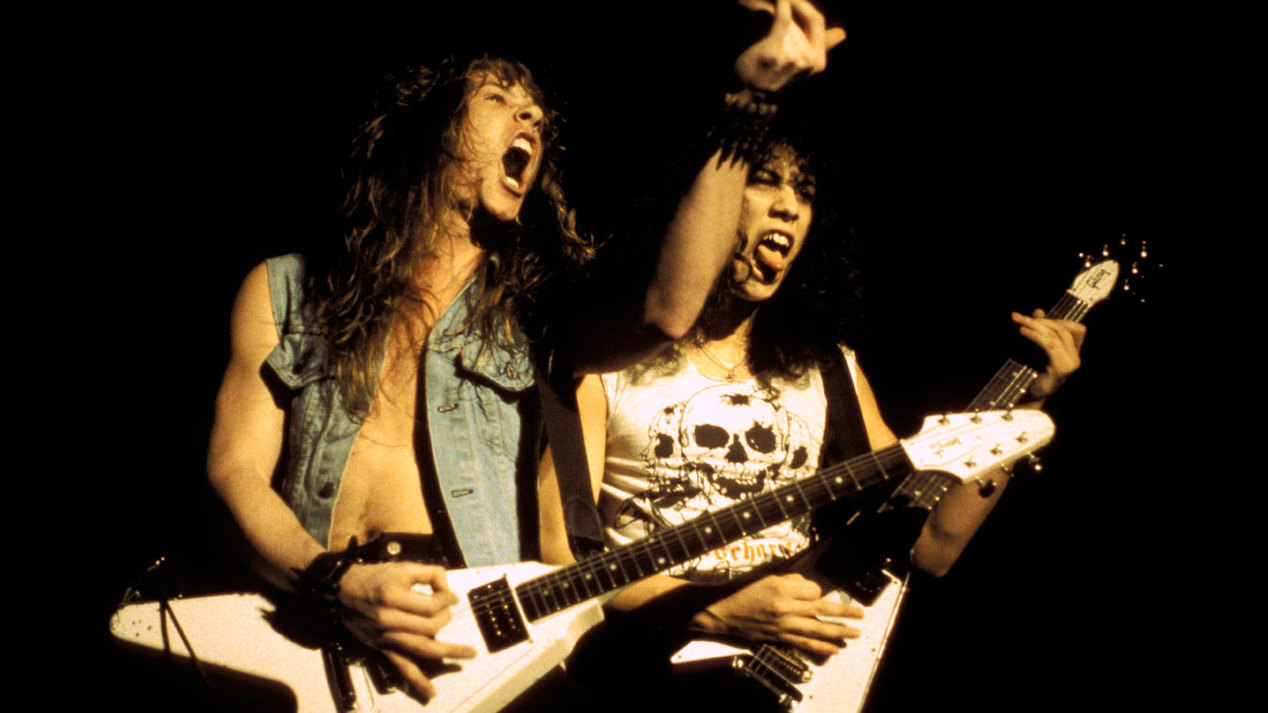You’ll no doubt recall that epic moment in Back To The Future when Marty McFly blasts through the next three decades of guitar histrionics during a solo at the high school dance: “I guess you guys aren’t ready for that yet. But your kids are gonna love it.” That statement neatly sums up the life and times of the Gibson Flying V.
Given its looks, and pedigree as a Weapon Of Metal Destruction, the Gibson Flying V should have been forged by some Norse God from molten lava and lightning bolts or some such. Its radical V-shaped body and arrow-profile headstock met the needs of rock and metal players looking for an eye-catching beast, and its aficionados include Andy Powell of Wishbone Ash, Metallica’s James Hetfield and Kirk Hammett and of course, Michael Schenker (Scorpions/UFO/Michael Schenker Group) whose favourite model of guitar is there to see in black and white.
It’s fair to say that the Flying V was ahead of its time. First launched in 1958, it was actually born as a prototype a year earlier at the Gibson factory in Kalamazoo, Michigan. The man behind the design was Gibson president Ted McCarty, the genius responsible for the Les Paul, ES-295, ES-335, SG and other models. McCarty wanted to build a range of futuristic looking guitars to compete with Fender’s hugely successful Stratocaster, something the company’s flagship Les Paul models had failed to achieve.
McCarty came up with three designs, two of which, the Flying V and the Explorer, became benchmarks for the perfect metal guitars influencing other manufactures like Jackson, Dean, ESP and Ibanez.
This all sounds great of course but the fact is, the Flying V, and the Explorer (and the third model, the lesser loved Moderne) bombed. Big time. The V was done by 1959. While these days an original ‘58 Flying V will chew a £200k size hole through your bank account, in the late 50s it’s claimed that some music store owners hung them outside their premises to direct the punters inside. Probably not true but a fun story…
Not everyone hated the Flying V. Almost from its inception, the model was championed by two blues heavyweights. The first was the recently departed Lonnie Mack whose ‘58 V, fitted with a Bigsby vibrato, was nicknamed “No. 7” as it was apparently the seventh example made. Mack’s instrumental recording of Memphis is the greatest example of a Flying V tone on a R&B record.
The other V pioneer is blues icon Albert King. “The Velvet Bulldozer” blew the minds of Eric Clapton, Paul Kossoff of Free and Gary Moore with his piercing Flying V tone on his 1967 Stax album Born Under A Bad Sign. Other blues rock guys like Johnny Winter and Leslie West dabbled with a V during their careers but Albert and his guitar (aka “Lucy”) are the pinnacle of V-fuelled blues.
Pre-metal honourable mentions must go to two V-brandishing cats who were instrumental in the rise of the hard stuff. Dave Davies of The Kinks was an early adopter of a ‘58 prototype V (you can see him using it on Tired Of Waiting). He would often hold the guitar with his arm in the body’s V cutout. Strat-lover Jimi Hendrix also made space for a psychedelic-painted ‘67 Flying V, using it during a performance of Red House at the Isle Of Wight Festival.
The Flying V was rescued by Gibson in 1967 and while it didn’t get close to the popularity of the SG and reinstated Les Paul models it was soon seized upon by the emerging hard rock and metal scene of the 70s and 80s. Users included Mick Ralphs in his Bad Company years, Paul Stanley of Kiss, British session guitarist, Sex Pistol mentor and honorary Womble Chris Spedding, and Michael Schenker’s brother Rudolph.
The V’s mahogany body and neck, twin humbuckers and classic 24.75” scale length account for its huge sustain and skull-crushing tone. That said, while it’s as tonally versatile as the Les Paul, SG and others but it just looks right in a metal setting. Probably the model’s greatest current ambassador is Zakk Wylde, who has a signature “Bulls-Eye Flying V Custom and the XV, a hybrid which looks like a SG with a V shoved up its arse.
Ok, it’s not as widely used as a Strat or taken quite as seriously as a Les Paul but in its own way the Flying V is just as influential. It inspired Randy Rhoads’ iconic Jackson model for one, a guitar that in turn spawned six-strings designed for the likes of Dave Mustaine of Megadeth, Phil Demmell of Machine Head and the aforementioned Mr Wylde. That said, surely the Flying V’s greatest moment was in the hands of bank-robbing KK Downing in Judas Priest’s Breaking The Law where just pulling off that killer riff pops open the vault.

